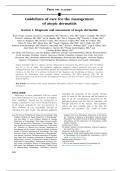Resume
Summary Guidelines of care for the management of atopic dermatitis
- Cours
- Établissement
FROM THE ACADEMY Guidelines of care for the management of atopic dermatitis Section 1. Diagnosis and assessment of atopic dermatitis Work Group: Co-chair, Lawrence F. Eichenfield, MD,a Wynnis L. Tom, MD,a Sarah L. Chamlin, MD, MSCI,b Steven R. Feldman, MD, PhD,c Jon M. Hanifin, MD,d Eric L. Si...
[Montrer plus]



